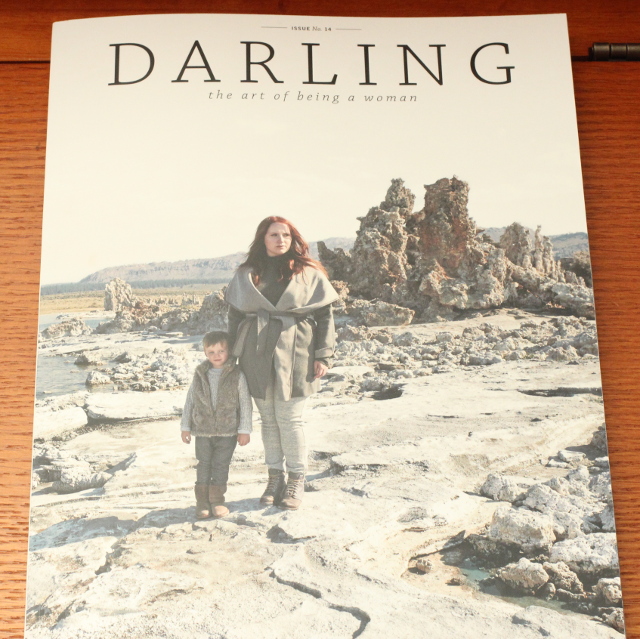Deconstructed: Darling Magazine

(Darling Magazine, Winter 2015.)
I’m a fan of Estée Lalonde’s funny YouTube channel, so I recently picked up a copy of Darling Magazine’s current issue, which features an essay by LaLonde and an accompanying photo series. Previously unfamiliar with the magazine, I was curious after Lalonde mentioned that it celebrates women and never uses Photoshop to “alter women’s bodies or faces.” It sounded like the kind of magazine I’d love to read, so I jumped at the chance and ordered a copy directly from Darling’s site.
Once it arrived, I eagerly read Lalonde’s essay on “Who I Am,” which was interesting, but almost sounded like she was writing a piece for a college application. Lalonde’s bubbly personality and crazy, improvised remarks make her channel a hit. Watching Estée online, she’s the cool girl, but reading her piece in print, she just falls flat. Her styled photos are lovely, but I don’t think they capture who she really is, which is kind of the point.
As I thumbed through the rest of Darling, I began to notice a common thread throughout the magazine’s stories. It wasn’t overtly obvious, but because I’m familiar with certain buzzwords and key phrases used by various church groups (I grew up in a Presbyterian church and was raised by a Southern Baptist mother and a Catholic father), I recognized an underlying Christian theme running throughout the magazine’s pages. In fact, the covert aspect became glaringly obvious by the time I reached the last page. Christian magazines for women have their place in popular culture, but I admit that I was surprised to notice this in a fairly mainstream publication that’s sold at Anthropologie.
Darling Magazine, if you aren’t familiar with it, is a lot like Kinfolk, but specifically geared to women. There are a lot of dreamy photos and beautiful pictures drawn by hand. It’s a substantial magazine printed on heavy paper, so it’s the kind of publication you linger over and save. Everyone knows that Kinfolk was started by a handful of students from Brigham Young University, but according to Nathan Williams, the magazine’s creator, it’s definitely not faith-based at all. Darling, on the other hand, definitely seems to target a certain demographic of Christian women, though you might have to squint really hard to realize it.
Darling’s mission statement appears on the back cover of the magazine, and it seems like a modern-day version of the Proverbs 31 Woman, an idea many Evangelical Christian women work endlessly to emulate. Darling focuses on “the arts of virtue, wit, modesty, and wisdom, all the while creating beauty and embodying love.” In the twenty-first century, what does that even mean? Are the magazine’s readers supposed to exhibit these traits, which seem to spring directly from a Jane Austen novel or a Shakespearean play? I find it very confusing.
No less confusing is the article about the dangers of pornography in Darling’s current issue. It’s written by the director of communications for the National Center on Sexual Exploitation, which, until its name change last year, was known as Morality in Media, a faith-based organization working to stamp out pornography and other issues it views as harmful to the “decency” of American media. You can see where this is going. Should a print magazine try to manage the morality of its readers? Shouldn’t it be more concerned with avoiding issues of censorship since Darling is, you know, a magazine that women buy?
To further add to this muddle, Darling’s winter issue also features an insightful interview with Uzo Aduba, the wonderful actress who plays Suzanne “Crazy Eyes” in “Orange is the New Black.” Aduba hints at her own spirituality, a mixture of New Age philosophy mixed with mentions of God, the universe, and Marianne Williamson. And, in case you haven’t seen the show on Netflix yet, much of the most recent season focuses on Suzanne’s talent as a writer of erotic stories, hilariously known as the Time Hump Chronicles. As Suzanne herself explains when her counselor calls the stories pornographic, “No, it’s not just sex. It’s love. It’s two people connecting…with four other people…and aliens.”
Another confusing aspect of Darling is its “Choose Your Own Adventure” list of personas at the bottom of the magazine’s site. Readers can pick a persona, with choices ranging from dreamer to stylist to beautician to intellectual, and find a selection of articles suited to each. But a persona isn’t real, it’s something you take on, a role, and the idea of women assuming these alternative identities, as they strive to be virtuous, witty, and modest, seems contrary to Darling’s professed desire for authenticity.
Darling doesn’t seem to know who or what it is as a magazine, and that obvious confusion sends a very conflicted message to its readers. It’s fine to be a Christian magazine, or an aspirational magazine meant to help women relax and escape for a bit, but it needs to figure things out. Until then, the overall theme just gets lost in translation.
